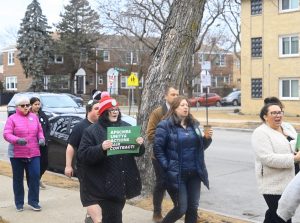Guest speakers give green light to environmental efforts
Bill Kurtis (left) and John St. Augustine have shared their passion for conservation for 27 years.
April 12, 2017
American broadcaster, Bill Kurtis and NEIU alumnus, Chicago author and radio personality, John St. Augustine were the keynote speakers at NEIU’s second annual Green Business Conference on April 4.
The pair host a radio show called “Earth Matters” on WCPT AM/FM in Chicago.
The GBC is coordinated by the Green Conservation Group, whose goal is to bring environmental awareness and green conservation efforts to NEIU. The business conference also is an opportunity for students to become familiar with green-oriented companies and find possible career paths or applications of their degrees towards environmental studies, said Valeria Martinez, vice president of the GCG and an environmental studies major at NEIU.
The GCG also has been making efforts to reach out to other departments throughout NEIU.
“We’re trying to bring more people in from different departments and areas of study to show that sustainability and conservation does not only pertain to environmental studies and geography majors,” Martinez said.
This year’s GBC keynote speakers presented pieces from their radio segment “Earth Matters” and discussed the importance of restoring and preserving Illinois grasslands.
St. Augustine, writer for the radio program, explained that he first became interested in environmental conservation efforts due to three key figures in his life. Theodore Roosevelt, the 26th U.S. president who prevented the mining of the Grand Canyon among various achievements; Jacque Cousteau, French filmmaker and conservationist, famous for marine conservation; and John Denver, famous singer-songwriter, humanitarian and promoter towards the conservation of natural resources.
“I was fascinated that one man could be visionary enough to save things other men would destroy,” St. Augustine said of Roosevelt. “And those three guys: John, Jacque and Teddy—they all played a role in my life in teaching me something and I really feel that they all hit me at the right time and I owe them for what they gave me.”
St. Augustine said that he later befriended Denver, whose music and messages he loved, and it was in fact while he attended one of Denver’s shows regarding conservation efforts at the Chicago Theater in 1989, that he met Bill Kurtis and they have been friends ever since.
St. Augustine graduated from NEIU with a degree in environmental interpretation and communication and has been doing conservation work through his writing for 25 years.
“I started to look in between the lines,” said St. Augustine. “Most people are looking at the headlines, I’m looking for the lifelines, and when you look in between the lines you’re able to extract information. You’d be amazed what information could lead to transformation.” This is the message he came to share at the GBC with the NEIU community.
“We have serious, serious challenges. I’m not concerned about the planet, I’m concerned about us,” St. Augustine said. “I’m concerned about my kids, my grandkids…I’m concerned about the 5,000 kids that die because they don’t clean the water. And we drink bottles of this stuff that we get at the gas station.”
One point St. Augustine made in a one-on-one interview was about small changes students here can do to reduce their plastic waste. “Even in the dorms there are things you can do, either get a Brita or drink out of the tap,” he said. “This bottled water stuff is out of hand.”
Their presentation also highlighted the concerning state of water and ground pollution that they believe is of utmost importance. Runoff into the U.S.’s waterways — specifically from commercial fertilizers such as those used on lawns — is the leading cause of this. A clip from their program explained that 55 percent of streams and rivers surveyed for a study by the EPA are not suitable for aquatic life due to high levels of phosphorus and nitrogen.
Not only does it affect the cleanliness of our natural water sources but it also affects the soil and inevitably the plant life in contaminated areas.
Commercial farming is also damaging the soil throughout Illinois’ prairielands. The use of fertilizers, pesticides and the disruption of the soil from constant farming hurts the organisms within the soil that sustain native prairie vegetation. In spite of this, Kurtis said that some farmers are using better conservation methods instead of traditional ones. “They’re using no-till cultivation to avoid turning the soil over and disturbing the organisms within it, and they grow crops without chemical weed control,” he said.
Kurtis explained that Illinois once had an abundance of prairie vegetation. The vegetation was comprised of several plants that adapted and evolved with the environment in order to survive in prairie conditions. The plants survived due to their immensely long roots which could reach several feet under the ground (some as far as 15 feet).
“Underneath the surface, and I mean really underground, there is a subterranean world that holds the key to fighting climate change,” Kurtis said of the native vegetation that can survive droughts, wildfires and being trampled and eaten by animals such as buffalo.
Prairie native plants are in fact the largest ecosystem in the world other than the Brazilian rainforest.
“What would happen if we return Illinois to a real prairie state? The tall grasses and the wild flowers stretching as far as you can see — it’s not an easy answer,” Kurtis said. “If we manage the grasslands of the world properly we could reduce the amount of carbon dioxide in the atmosphere by three percent in five years.”
Currently Kurtis said that the concentration of carbon dioxide in the air rose from 275 ppm (parts per million) in 1958 to 400 ppm as of this year.
“Even though the prairie grasslands could save us from climate change in Illinois we have destroyed all but one-tenth of one percent of our native prairies,” Kurtis said.
Commercial fertilizer has been a major culprit to the decimation of U.S. grasslands. The chemicals from the fertilizers seep down five feet into the soil and kill the microorganisms that naturally give the soil its nutrition. It would take five to ten years to rejuvenate the soil, ceasing the use of chemicals in the process.
Kurtis urged the audience to contact Senator Dick Durbin and other Illinois politicians to demand change.







